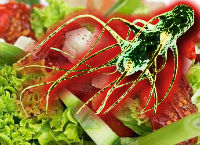Organism Details:
Shape and Size
�0�.�5�-�0�.�8� �¼�m� �,� �R�o�d�-�S�h�a�p�e�d�.
Genome Information
Clostridium botulinum F str. Langeland chromosome (GI:153937894) has a circular DNA chromosome of 3995387 bp. The genome structure of Clostridium botulinum consists of 2,513 genes and 2,475 coding proteins, no any Pseudo Genes, rRNAs: 2 ( 5S, 16S, 23S ), tRNAs: 36. The GC content of Clostridium botulinum is about 28.0%.
Food Source
Low-acid canned foods, meats,sausage,fish,vegetables, condiments (e.g. pepper), fish, canning, fermentation, curing, smoking, or acid or oil preservation,vegetables,.products (type E), meat and meat products, garlic in oil and baked potatoes. Preserved food e.g. Canning, fermentation, curing, smoking, or acid or oil preservation.
Pathological Factor
�C�l�o�s�t�r�i�d�i�u�m� �b�o�t�u�l�i�n�u�m� �c�a�n� �p�r�o�d�u�c�e� �t�h�e� �m�o�s�t� �p�o�t�e�n�t� �b�i�o�l�o�g�i�c�a�l� �n�e�u�r�o�t�o�x�i�n�s� �w�h�i�c�h� �i�f� �i�n�g�e�s�t�e�d�,� �r�e�s�u�l�t� �i�n� ��b�o�t�u�l�i�s�m ��.� �T�h�e�r�e� �a�r�e� �e�i�g�h�t� �r�e�c�o�g�n�i�s�e�d� �a�n�t�i�g�e�n�i�c�a�l�l�y� �d�i�s�t�i�n�c�t� �t�o�x�i�n�s�,� �d�e�s�i�g�n�a�t�e�d� �a�s� �t�y�p�e�s� �A�,� �B�,� �C�±�,� �C�²�,� �D�,�E�,� �F� �a�n�d� �G�.�A�l�l� �a�r�e� �n�e�u�r�o�t�o�x�i�n�s� �e�x�c�e�p�t� �C�²� �w�h�i�c�h� �i�s� �a�n� �A�D�P�-�r�i�b�o�s�y�l�a�t�i�n�g� �e�n�z�y�m�e�E�a�c�h� �o�f� �t�h�e�s�e� �s�u�b�t�y�p�e�s� �p�r�o�d�u�c�e� �a� �d�i�f�f�e�r�e�n�t� �b�o�t�u�l�i�n� �t�o�x�i�n�,� �a�l�l� �o�f� �w�h�i�c�h�,� �w�i�t�h� �t�h�e� �e�x�c�e�p�t�i�o�n� �o�f� �C� �a�n�d� �D�,� �a�r�e� �h�u�m�a�n� �p�a�t�h�o�g�e�n�s�.� � � � � � � � � � � � � � � � � � � � � � � � � � � � � � � � � � � � � � � � � � � � � � � � � � � � � � � � � � � � � �B�o�t�u�l�i�n�u�m� �n�e�u�r�o�t�o�x�i�n� �f�o�r�m� �i�n�i�t�i�a�l�l�y� �a�s� �s�i�n�g�l�e�-�c�h�a�i�n� �p�o�l�y�p�e�p�t�i�d�a�s�e� �w�i�t�h� �M�.�w�t� �1�5�0� �k�D�a� �a�n�d� �r�e�l�a�t�i�v�e�l�y� �l�e�s�s� �t�o�x�i�c�.�P�r�o�t�e�i�o�l�y�t�i�c� �C�.�b�o�t�u�l�i�n�u�m� �s�i�n�g�l�e� �c�h�a�i�n� �f�o�r�m� �i�s� �u�s�u�a�l�l�y� �c�l�e�a�v�e�d� �b�y� �a� �c�l�o�s�t�r�i�d�i�a�l� �p�r�o�t�e�a�s�e�s� �f�o�r�m� �a� �d�i�c�h�a�i�n� �i�n� �f�o�o�d� �a�n�d� �c�a�u�s�e�s� �f�o�o�d�-�b�o�r�n�e� �i�l�l�n�e�s�s�,� �i�n�f�a�n�t�,� �a�n�d� �w�o�u�n�d� �b�o�t�u�l�i�s�m� �P�r�o�t�e�o�l�y�t�i�c� �C�l�o�s�t�r�i�d�i�u�m� �b�o�t�u�l�i�n�u�m� �n�e�u�r�o�t�o�x�i�n� �c�a�u�s�e�s� �f�o�o�d�-�b�o�r�n�e� �i�l�l�n�e�s�s�,� �i�n�f�a�n�t�,� �a�n�d� �w�o�u�n�d� �b�o�t�u�l�i�s�m�.�T�h�e� �b�o�t�u�l�i�n�u�m� �t�o�x�i�n�s� �m�o�s�t� �a�c�t�i�v�e� �f�o�r�m�s� �a�r�e� �a�s� �d�i�c�h�a�i�n� �m�o�l�e�c�u�l�e�s�,� �w�h�e�r�e� �h�e�a�v�y� �c�h�a�i�n�s� �a�r�e� �l�i�n�k�e�d� �t�o� �l�i�g�h�t� �c�h�a�i�n�s� �v�i�a� �d�i�s�u�l�p�h�i�d�e� �b�o�n�d�i�n�g�.� �T�o�x�i�c�i�t�y� �h�a�s� �a�p�p�e�a�r�e�d� �t�o� �b�e� �a�s�s�o�c�i�a�t�e�d� �w�i�t�h� �t�h�e� �L� �c�h�a�i�n�,� �w�h�i�c�h� �b�l�o�c�k�s� �p�r�i�m�a�r�i�l�y� �o�n� �p�e�r�i�p�h�e�r�a�l� �c�h�o�l�i�n�e�r�g�i�c� �s�y�n�a�p�s�e�s� �t�o� �p�r�e�v�e�n�t� �t�h�e� �c�a�l�c�i�u�m� �m�e�d�i�a�t�e�d� �r�e�l�e�a�s�e� �o�f� �a�c�e�t�y�l�c�h�o�l�i�n�e�,� �m�o�s�t� �l�i�k�e�l�y� �i�n�t�e�r�f�e�r�i�n�g� �w�i�t�h� �t�h�e� �m�e�c�h�a�n�i�s�m� �o�f� �e�x�o�c�y�t�o�s�i�s� �w�h�e�r�e� �v�e�s�i�c�l�e�s� �c�o�n�t�a�i�n�i�n�g� �n�e�u�r�o�t�r�a�n�s�m�i�t�t�e�r�s� �f�u�s�e� �w�i�t�h� �t�h�e� �c�e�l�l� �m�e�m�b�r�a�n�e�.� �T�h�e� �t�o�x�i�n� �p�r�e�v�e�n�t�s� �t�h�e� �p�r�o�p�a�g�a�t�i�o�n� �o�f� �a�c�t�i�o�n� �p�o�t�e�n�t�i�a�l�s� �t�o� �t�h�e� �m�u�s�c�l�e� �f�i�b�e�r�s�,� �i�n�d�u�c�i�n�g� �p�a�r�a�l�y�s�i�s� �b�y� �i�n�h�i�b�i�t�i�n�g� �m�u�s�c�l�e� �c�o�n�t�r�a�c�t�i�o�n�.
Disease
Nuerotoxin act primarily at peripheral cholnergic synapses,where they block the release of the nuerotransmitter acetylcholine .The heavy chain of the toxin is involoved in binding and entery into the motor nueron and the light chain act as an endopeptidase enzymes ,degrading nueron protien involoved in release of acetycholine.Botulism symptoms can be caused by consumption of food contamination of about 10mg or 5ul of food has caused botulism. A main cause of death from this botulism involve death by asphyxiation, which is caused by the inability of the chest muscles to contract to facilitate breathing. Other effects of botulism, which affects both man and animals, include impaired vision and widespread muscular weakness.
Although antitoxins do exist for this disease, by the time the symptoms of botulism show the toxin is irreversibly bound. Antitoxins may serve to neutralize the unbound toxin, but it is unable to reverse the binding of any toxins that are already exacting their effect.Also responsible causing diasease like Fatigue, Neurological disorders, Diarrhea disorders.
Affected Body Organs
paralysis of respiratory muscles
|








